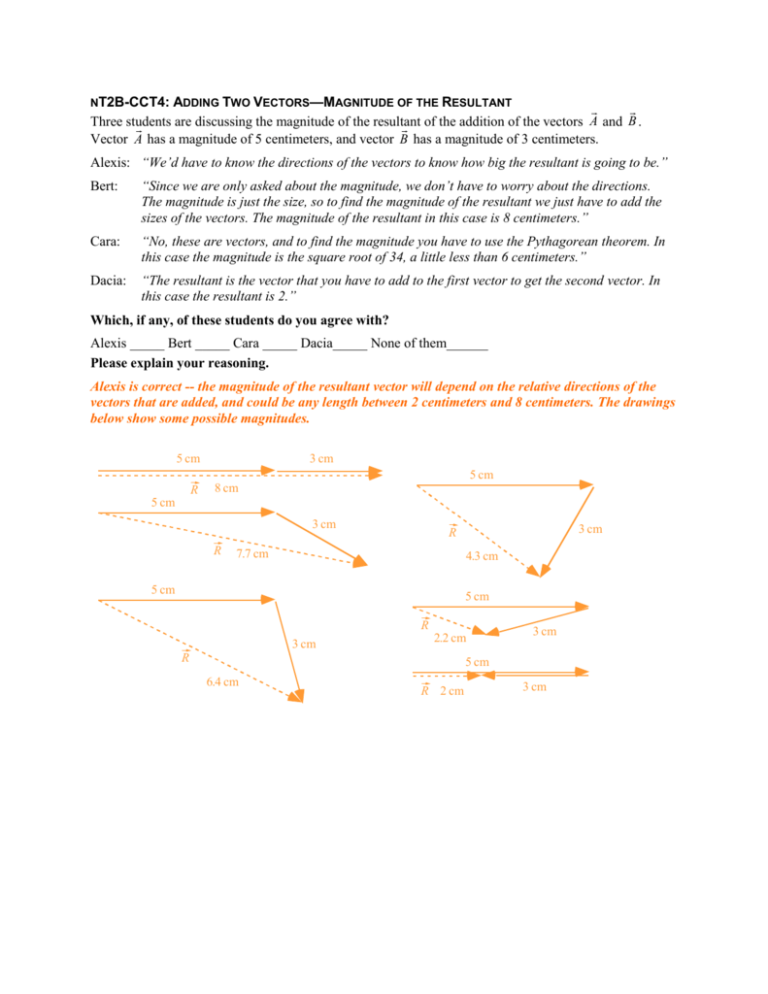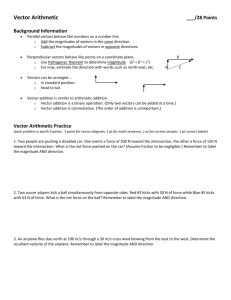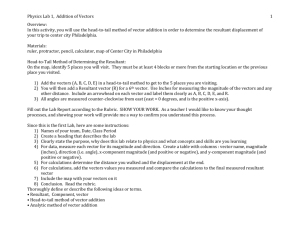nT2C-CT11: Two Vectors—Vector Sum and Difference
advertisement

ADDING TWO VECTORS—MAGNITUDE OF THE RESULTANT Three students are discussing the magnitude of the resultant of the addition of the vectors A and B . Vector A has a magnitude of 5 centimeters, and vector B has a magnitude of 3 centimeters. NT2B-CCT4: Alexis: “We’d have to know the directions of the vectors to know how big the resultant is going to be.” Bert: “Since we are only asked about the magnitude, we don’t have to worry about the directions. The magnitude is just the size, so to find the magnitude of the resultant we just have to add the sizes of the vectors. The magnitude of the resultant in this case is 8 centimeters.” Cara: “No, these are vectors, and to find the magnitude you have to use the Pythagorean theorem. In this case the magnitude is the square root of 34, a little less than 6 centimeters.” Dacia: “The resultant is the vector that you have to add to the first vector to get the second vector. In this case the resultant is 2.” Which, if any, of these students do you agree with? Alexis _____ Bert _____ Cara _____ Dacia_____ None of them______ Please explain your reasoning. Alexis is correct -- the magnitude of the resultant vector will depend on the relative directions of the vectors that are added, and could be any length between 2 centimeters and 8 centimeters. The drawings below show some possible magnitudes. 5 cm R 5 cm 3 cm 5 cm 8 cm 3 cm R 3 cm R 7.7 cm 4.3 cm 5 cm 5 cm R 3 cm 2.2 cm R 3 cm 5 cm 6.4 cm R 2 cm 3 cm NT2B-QRT5: VECTORS ON A GRID III—GRAPHICAL REPRESENTATION OF SUM Shown below are four scaled vectors labeled K , L , M , and N with lengths in arbitrary units. y y H L M A B G K C F L E D J x x M N K N On the right, construct a graphical representation on the right of J K L M N with labels for each vector, and indicate the direction of J ____D______ (closest to one of the directions listed in the direction rosette above). tail of the first vector drawn to the head of Vectors add head-to-tail with the resultant pointing from the the last vector drawn. NT2B-RT6: VECTORS I—RESULTANT MAGNITUDES OF ADDING TWO VECTORS Eight vectors are shown superimposed on a grid. A C D E B F G H Rank the magnitude of the vector resulting from adding vector A to each vector ( A A , B A , C A , etc). Greatest 1_______ 2_______ 3_______ 4_______ 5_______ 6_______ 7_______ 8______ Least OR, All of these resulting vectors have the same magnitude. ____ OR, We cannot determine the ranking for the magnitudes of the resulting vectors. ____ Please explain your reasoning. Answer A > B > E = F > G > H > C > D. The resultants are shown as dashed lines below, found by adding the vectors head-to-tail. For the vectors that are collinear, the lengths can be found by adding the magnitudes of the vectors (or by subtracting them if they point in opposite directions). For vectors at right angles, the magnitude of the resultant can be found with the Pythagorean theorem. A A A C D A A A B A E F A G NT2B-CCT7: COMBINING TWO VECTORS—RESULTANT Two vectors each have a magnitude 6 units, and each makes a small angle with the horizontal as shown. Four students are arguing about the resultant vector obtained by adding these two vectors. 6 6 Amanda: “Since these are vectors, we need to use the Pythagorean theorem to find the magnitude. In this case, the magnitude will be the square root of 72. The direction will be downward.” Belle: “Since these are vectors we have to find a direction and a magnitude. We use the vectors to determine the direction, which is down. But to get the magnitude, we just add the individual magnitudes. The magnitude of the resultant is twelve.” Conrad: “I think the direction is actually up. The resultant should add to these vectors to get zero, and since these ones point down, we need another vector pointing up.” Donald: “The magnitude will be less than six. Each of these point down just a little so the resultant will be pretty small.” Which, if any, of these students do you agree with? Amanda _____ Belle _____ Conrad _____ Donald _____ None of them______ Please explain your reasoning. Donald is correct. The resultant can be found by vector addition as shown here. The resultant points down and is smaller than either individual vector. However, Donald neglects to specify the direction, which is down as Amanda and Belle correctly point out. 6 R 6 NT2B-CT8: COMBINING VECTORS—MAGNITUDE OF RESULTANT In Case A, two vectors of magnitude 6 units are at right angles to one another. In Case B, four vectors, each of magnitude 3 units, are arranged as shown. The outer vectors in Case B are also at right angles to one another, and the difference in direction between any pair of adjacent vectors is 30°. 45° 45° 45° 3 6 6 45° 30° 30° 30° 3 3 Case A 3 Case B If all vectors in each case are added together, is the magnitude of the resultant in Case A greater than, less than, or equal to the magnitude of the resultant in Case B? Please explain your reasoning. (b) Less than; in both cases, the horizontal components of the vectors will cancel, and the resultant will point straight down. In case B, the vertical component of each inner vector is greater than the vertical component of each outer vector. If we rotated these inner vectors outward so that they were at an angle of 45° to the horizontal, their vertical components would become smaller, and the vector sum of the 4 vectors would be the same as the sum in case A. 6 3 3 Case A Case B 3 6 3 A NT2B-QRT9: VECTOR COMBINATION II—DIRECTION OF RESULTANT For each situation below, combine the vectors as indicated and determine the direction of the resultant vector. Then select the closest direction to the resultant from the direction rosette at the right. J=N +P+Q+R K=P+R+N+Q Direction of J: y Direction of K: y H B C G F D E R P P N x Q x Q R N L=– S – T+U– V M=U– T– V– S Direction of L: y Direction of M: y U T U T x V S x V S The easiest way to find the resultants in these cases is to add the components. For example, to find J , we can add the x-components of N , P , Q , and R : 3 + (–2) + (–1) + 2 = 2, and the y-components of the same vectors: 1 + 3 + 0 + (–2) = 2. So if the tail of the resultant J was placed at the origin, the head would be at (2, 2) and the direction of J is the same as the direction of B . Following the same K B procedure, we find thatthe head of vector would be at (2, 2), again giving answer ; for vector L we get (0, 2) corresponding to direction C , and for vector M we get (0, 2), again corresponding to direction C . NT2C-CCT10: TWO VECTORS—VECTOR DIFFERENCE Two vectors labeled A and B , each having a length of 6 meters, make a small angle with the horizontal as shown. Four students are arguing about the vector difference C A B . Arlo: Bob: 6 A B 6 “Since we’re subtracting vector B, we flip it around so it points in the same direction as vector A. The difference will be 12 meters long and will point in the same direction as vector A.” “We’re subtracting, so the resultant will be smaller than six. Both vectors point down, so the difference will point down as well.” Celine: “When you flip vector B around to get negative B, it points up and to the left. Then we add it to vector A, we get a long vector pointing horizontally to the right.” Delbert: “Both vectors are 6 meters long, so the difference is zero. It doesn’t point in any direction.” Which, if any, of these students do you agree with? Arlo _____ Bob _____ Celine _____ Delbert _____ None of them______ Please explain your reasoning. None of the students is correct, although Celine is close. The difference will be almost 12 meters long and will point to the left. D 6 –B 6 A NT2C-CT11: TWO VECTORS—Vector SUM AND DIFFERENCE Two vectors labeled A and B each have a magnitude of 6 meters, and each makes a small angle with the horizontal as shown. Let C A B and D A B . B 6 6 A Is the magnitude of C greater than, less than, or equal to the magnitude of D ? Please explain your reasoning. Less than. Vector C points downward and is smaller than six meters as shown in the vector sum here. Vector D points to the left and is larger than six meters as shown in the vector difference here. 6 A D C B 6 6 –B 6 A NT2C-RT12: ADDITION AND SUBTRACTION OF THREE VECTORS I—MAGNITUDE Shown are three vectors labeled R , S , and T , with lengths given in arbitrary units. Rank the magnitudes of the vectors A through F formed by adding T as described below. R , S , and and subtracting vectors A R S T D R S T B R S T E S T R R 3 S 2 T C T R S F R S T Greatest 5 1 ______ 2 ______ 3 ______ OR, The magnitude of the vectors A – F is the same. 4 ______ 5 ______ 6 ______ Least ___ OR, The ranking for the magnitude of the vectors A – F cannot be determined. ___ Please explain your reasoning. The correct ranking is D = E > B = C > F > A. Since vector addition is commutative, B and C must be the same vector. D and E must have thesame magnitude, since E = –D. The ranking can be found by graphically adding the vectors as shown. T 2 A 3 5 R 5 S R T B –S 3 C R T 2 5 –S 5 –R R 3 T 2 E D S 3 –S 3 F 2 –T R 5 3 S –T 2






